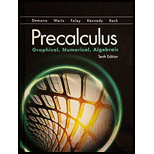
a.
To determine: The population of Mexico City surpass the population of United States by using the exponential growth model and fined the year, if surpassed.
The population surpasses in the year 2133.
Given Information:
The table is defined as,
| Year | Population |
| 1900 | |
| 1950 | |
| 1960 | |
| 1970 | |
| 1980 | |
| 1990 | |
| 2001 | |
| 2011 | 115 |
| 2016 |
Calculation:
Consider the given polynomial,
Using a graphing calculator, enter the year values starting from
Step 1. Press the tables’ option and enter the values as mentioned above.

Step 2. Use the Logistic feature to find the exponential regression model.
Display values are following as,
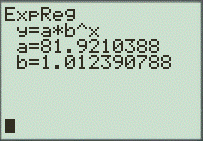
Thus, the function can be written as following,
Similarly, find the exponential model by using the calculator.
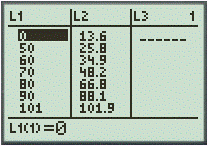
Now, use Logistic function to find the exponential regression model.
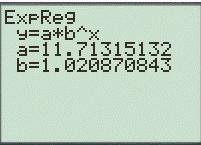
Thus, the function can be written as following,
Now, draw both the function o graphing calculator. Set the window of the calculator as following,
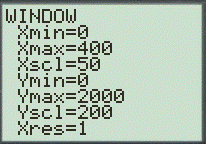
Now, draw both the obtained result.
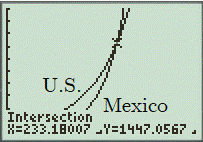
This implies that graph the exponential models on the same viewing window which shows that they intersect at the point
Therefore, the population surpass in the year 2133.
b.
To determine: The population of Mexico City surpass the population of United States by using the logistic model and fined the year, if surpassed.
The population do not surpass in logistic model.
Given Information:
The table is defined as,
| Year | Population |
| 1900 | |
| 1950 | |
| 1960 | |
| 1970 | |
| 1980 | |
| 1990 | |
| 2001 | |
| 2011 | 115 |
| 2016 |
Explanation:
Consider the given information,
Using a graphing calculator, enter the year values starting from
Step 1. Press the tables’ option and enter the values as mentioned above.
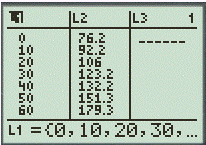
Step 2. Use the Logistic feature to find the exponential regression model.
Display values are following as,

Thus, the function can be written as following,
Similarly, find the exponential model by using the calculator.
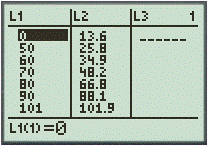
Now, use Logistic function to find the exponential regression model.
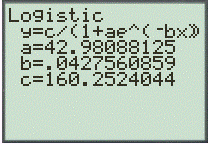
Thus, the function can be written as following,
Now, draw both the function o graphing calculator. Set the window of the calculator as following,
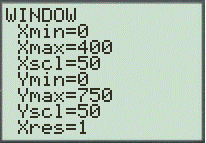
Now, draw both the obtained result.

Graph the logistic models on the same viewing window which shows that they never intersect. Thus, Mexico's population will never surpass the United States' population.
Therefore, the population do not surpass in logistic model.
c.
To determine: The maximum sustainable population for the both countries.
The population is
Given Information:
The table is defined as,
| Year | Population |
| 1900 | |
| 1950 | |
| 1960 | |
| 1970 | |
| 1980 | |
| 1990 | |
| 2001 | |
| 2011 | 115 |
| 2016 |
Explanation:
Consider the given information,
Refer the both model form the previous part (b).
The united state population model is defined as,
And the Mexico city population model is defined as,
By taking the c -values of the both models (numerator values and denominator as 1), the maximum sustainable populations are about 702.32 million for the United States and about 160.25 million for Mexico.
Therefore, the population is
d.
To determine: The model from both type is more valid in the given case and explain your answer.
The required model is logistic model.
Given Information:
The table is defined as,
| Year | Population |
| 1900 | |
| 1950 | |
| 1960 | |
| 1970 | |
| 1980 | |
| 1990 | |
| 2001 | |
| 2011 | 115 |
| 2016 |
Explanation:
Consider the given information,
Refer the both model form the previous part (b).
The united state population model is defined as,
And,
And the Mexico City population model is defined as,
And,
Therefore, the logistic models seem to be more valid as the growth rate of Mexico is smaller than the United States.
Chapter 3 Solutions
EBK PRECALCULUS:GRAPHICAL,...-NASTA ED.
- Use a graphing calculator to find where the curves intersect and to find the area between the curves. y=ex, y=-x²-4x a. The left point of intersection is (Type integers or decimals rounded to the nearest thousandth as needed. Type an ordered pair.)arrow_forwardFind the area between the curves. x= -5, x=3, y=2x² +9, y=0 The area between the curves is (Round to the nearest whole number as needed.)arrow_forwardcan you solve these questions with step by step with clear explaination pleasearrow_forward
- Find the area between the following curves. x=-1, x=3, y=x-1, and y=0 The area between the curves is (Simplify your answer.)arrow_forwardFind the area between the curves. x= − 2, x= 3, y=5x, y=x? - 6 6 The area between the curves is (Simplify your answer.) ...arrow_forwardplease question 9arrow_forward
- Use the definite integral to find the area between the x-axis and f(x) over the indicated interval. Check first to see if the graph crosses the x-axis in the given interval. 3. f(x) = 4x; [-5,3]arrow_forwardUse the definite integral to find the area between the x-axis and f(x) over the indicated interval. Check first to see if the graph crosses the x-axis in the given interval. f(x)=3e-4; [3,3]arrow_forwardA small company of science writers found that its rate of profit (in thousands of dollars) after t years of operation is given by P'(t) = (7t + 14) (t² + 4t+7) * (a) Find the total profit in the first four years. (b) Find the profit in the sixth year of operation. (c) What is happening to the annual profit over the long run?arrow_forward
- Calculus III May I have an expert explained how the terms were simplified into 6(3-x)^2? Thank you,arrow_forwardCalculus III May I have an expert explain how the integrand was simplified into the final for form to be integrated with respect to x? Thank you,arrow_forwardCalculus lll May I please have the semicolon statement in the box defined with explanation? Thank you,arrow_forward
 Calculus: Early TranscendentalsCalculusISBN:9781285741550Author:James StewartPublisher:Cengage Learning
Calculus: Early TranscendentalsCalculusISBN:9781285741550Author:James StewartPublisher:Cengage Learning Thomas' Calculus (14th Edition)CalculusISBN:9780134438986Author:Joel R. Hass, Christopher E. Heil, Maurice D. WeirPublisher:PEARSON
Thomas' Calculus (14th Edition)CalculusISBN:9780134438986Author:Joel R. Hass, Christopher E. Heil, Maurice D. WeirPublisher:PEARSON Calculus: Early Transcendentals (3rd Edition)CalculusISBN:9780134763644Author:William L. Briggs, Lyle Cochran, Bernard Gillett, Eric SchulzPublisher:PEARSON
Calculus: Early Transcendentals (3rd Edition)CalculusISBN:9780134763644Author:William L. Briggs, Lyle Cochran, Bernard Gillett, Eric SchulzPublisher:PEARSON Calculus: Early TranscendentalsCalculusISBN:9781319050740Author:Jon Rogawski, Colin Adams, Robert FranzosaPublisher:W. H. Freeman
Calculus: Early TranscendentalsCalculusISBN:9781319050740Author:Jon Rogawski, Colin Adams, Robert FranzosaPublisher:W. H. Freeman
 Calculus: Early Transcendental FunctionsCalculusISBN:9781337552516Author:Ron Larson, Bruce H. EdwardsPublisher:Cengage Learning
Calculus: Early Transcendental FunctionsCalculusISBN:9781337552516Author:Ron Larson, Bruce H. EdwardsPublisher:Cengage Learning





